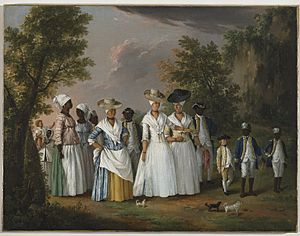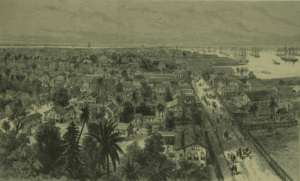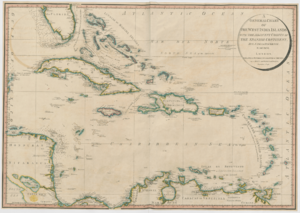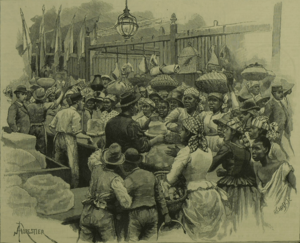Dorothy Thomas (entrepreneur) facts for kids
Quick facts for kids
Dorothy Thomas
|
|
|---|---|
| Born |
Dorothy Kirwan
1756 Montserrat, British Leeward Islands
|
| Died | 1846 (aged 89–90) Demerara, British Guiana
|
| Nationality | British |
| Other names | Doll Thomas, Dolly Kirwan |
| Occupation | businesswoman |
| Children | 11; including Dorothea Christina Thomas |
| Relatives | Henrietta Catharina Florentina Simon (granddaughter) George Augustus Sala (great-grandchild) |
Dorothy Thomas (born 1756, died 1846) was an amazing businesswoman from the Caribbean. She was also known as Dolly Kirwan or Doll Thomas. Born into slavery, she bought her own freedom. Then, she spent nearly 16 years working to free her children, her mother, and other family members.
Dorothy Thomas ran many businesses. She owned hotels and even a French restaurant. Her main way of making money was by hiring out women called hucksters. These women sold goods to plantation workers and enslaved people. She also rented out her own enslaved people as workers, ran lodging houses, managed a plantation, and rented out properties she owned.
She was one of the few black women who received money from the British government when slavery was abolished. She got £3,413 for the loss of her workers when Britain ended slavery in 1833. This was a huge amount of money at the time.
Dorothy Thomas often traveled to London. She made sure her children and grandchildren got a good education in Britain. Even though her daughters married important white businessmen, Dorothy was often the one who helped their families when they faced money problems. She had many important friends and business connections in the British West Indies. She used these connections to improve her life and help her family.
In 1824, while in London, she spoke out against a unfair law that targeted free women of color. She successfully convinced the colonial government to change it. Dorothy Thomas lived a long life, dying in 1846. She left behind a large and successful family spread across the British Empire. Her life story gives us a lot of information about what it was like for free women of color during her time.
Contents
Early Life and Freedom
Dorothy Kirwan was born into slavery in Montserrat around 1756. Her mother, Betty, was enslaved by the Kirwan family. Dorothy's owner was Andrew Kirwan, who called her "Dolly." She was given the Kirwan family name and raised as a Catholic. Because she was described as "mulatto" (a term used then for people of mixed race), it's thought that a member of the Kirwan family was her father.
We don't know much about her early life before she moved to Dominica. But she had already given birth to three children. Even though she couldn't read or write, she was very smart in business. She made sure her children's records showed their fathers' names correctly when they were freed. Her oldest daughter, Elizabeth Kirwan, was likely fathered by Andrew Kirwan or another family member. Her second child was Catherina Cells, probably the daughter of a planter named John Coesvelt Cells. Her son, Edward Iles, was the son of planter Ellis Iles.
Life in Montserrat became very hard by 1781. During the American Revolutionary War, trade with the Thirteen Colonies was stopped. This meant fewer supplies. The land was also worn out from too much farming. More than 1,200 enslaved people died from hunger. A terrible hurricane also hit Montserrat.
Andrew Kirwan decided to move to Demerara. Before he left, Dorothy arranged for her son Edward to be freed on July 24, 1781. Around that time, William Foden bought Dorothy from Andrew Kirwan. William Foden was the father of two more of her children, William and Charlotte Foden. Later, Dorothy bought the freedom of her two oldest daughters.

Dorothy, Foden, and her son Edward left Montserrat for Dominica. Foden worked as a manager on a plantation there. Foden died in 1782. In 1784, Dorothy went to the people in charge of his will to get what he left her. Foden's will said she would get his household goods and one-third of his animals. It also said she didn't owe him any money. The will also stated that she had paid him to free herself and her three children: William, Charlotte, and a baby named Ann (or Nan). Ann was the daughter of Joseph Thomas, a small merchant.
The people handling Foden's will agreed to free Dorothy and her children. They prepared a formal document to grant their freedom on July 10, 1784. Joseph Thomas and Alexander Fraser witnessed this document.
Joseph Thomas owned part of a merchant ship called the Mary. He traded goods between islands from Grenada. Joseph was the most important partner in Dorothy's life. Around 1785–1786, she had another daughter, Francis "Fanny" Owens. Fanny was likely the daughter of John Owens, a ship captain. In August 1786, Joseph returned to Dominica. He witnessed a document freeing a slave named Sally, who might have been Dorothy's grandmother. Joseph bought part of a second trading ship, the Jack. In March 1787, Joseph, Dorothy, and her family moved to Grenada.
Life in Grenada (1787–1799)
In Grenada, Dorothy Kirwan ran her own businesses. She signed her own deals. It's not clear if she had a shop or hired hucksters there. But she owned a hotel in St. George's, Grenada. She might have had other businesses too.
She had four more children with Joseph Thomas. They were all baptized in the Anglican Church: Eliza (1787), Joseph (1789), Harry (1790), and Christina (1796). All were recorded as children of Joseph and Dorothy, who was called "a free mulattress." This meant they were seen as legitimate children. It's possible Joseph and Dorothy had a private marriage agreement. However, public marriage vows were difficult for them due to social rules at the time. Dorothy also made sure her family's freedom papers were officially recorded in Grenada. This way, their free status would not be questioned.
During the French Revolutionary Wars, Joseph's business struggled. His ship Mary and its cargo were taken in 1794. His ship Jack sank in 1797. As Joseph's money problems grew, Dorothy's wealth increased. After Fédon's rebellion (a revolt led by French-speaking free people of color), Dorothy emphasized her ties to her English partner. She also quietly downplayed her Catholic faith. The Grenada Assembly and governor started making laws to remove freed slaves, especially free women of color. Seeing this change, Dorothy freed her mother in October 1797. Dorothy stayed in Grenada for a few years after Joseph's death, which was probably in 1799. Then, she moved to Bridgetown, Barbados.
Moving to Barbados (1799–1807)
Barbados was a good choice for Dorothy because she had family and friends there. Her daughters Elizabeth and Ann were married and living there. Her sister Henrietta Moore also lived in Barbados. John Owens, the ship captain who fathered Dorothy's daughter Fannie, was also there. Bridgetown was where the British Caribbean fleet was based. War created business chances, but there was also strong competition from other free women of color.
Dorothy started looking for better opportunities. She considered the Dutch Colony of Demerara. By 1800, two-thirds of the white people in Demerara were British, many from Barbados. More free people of color were also moving to Demerara from all over the British West Indies. This happened because the Dutch Republic collapsed in 1795. The British then took over Demerara to stop it from falling into French hands. The colony was given back to the Dutch, but the British took it again in 1803. It officially became British rule between 1814 and 1815. Dorothy's daughter Catherina had moved to Demerara in the 1790s. Her daughters Charlotte and Eliza followed in 1802 and 1805.
Life in Demerara (1807–1846)

Dorothy moved to Demerara by 1807. At first, she was known by her last name, Kirwan. But after 1808, she insisted on being called Mrs. Thomas. She opened a rooming house near Werk-en-rust, a plantation on the edge of Georgetown. Within a year, she moved to a new, fashionable area called Cumingsburg. She bought several plots of land there. In 1808, she paid taxes for 16 enslaved people. Newspaper ads showed she offered lodging and used her enslaved people as hucksters.
The old plantation system, where estates provided everything, had changed. Plantation owners now bought goods once or twice a year. Traveling peddlers, or hucksters, brought extra supplies. Since people lived far apart, shops were not practical. Hucksters were very important to society.
Dorothy used her white sons-in-law to get supplies on credit for her hucksters. She sent them out to the countryside to sell their goods. Her business became very profitable. Sometimes, she would post notices about enslaved people who had run away with her goods. Many of her hucksters were women. But she also advertised services for male enslaved people as boatmen, carpenters, or painters. Women were hired out as housekeepers, nursemaids, and seamstresses. She also leased out properties she owned in and around Georgetown.
By 1810, Dorothy was very wealthy. She traveled to England with her youngest children, Henry and Christina, and 17 of her grandchildren. The girls went to Kensington House Academy, a finishing school in London that Dorothy supported. The boys went to Dollar Academy near Glasgow. That year, Dorothy moved again to Robb Street, the most fashionable street in Georgetown.
By 1815, Dorothy was running the Kensington plantation with her daughter Charlotte and son-in-law, Gilbert Robertson. Her largest hotel had a cistern that could hold over 5,000 gallons of water. In 1817, she hired a French chef, Louis le Plat. That same year, she bought a live lion from Africa to entertain her guests. Local newspapers reported her buying and selling properties near the port and in other areas. In 1819, she hosted a party for Stapleton Cotton, 1st Viscount Combermere, the Governor of Barbados. By the 1820s, Dorothy regularly traveled abroad with servants. She was known as one of the richest people in the colony. In 1820, she owned 83 enslaved people. While her business was doing well, her white sons-in-law often needed financial help, which she provided, sometimes reluctantly. They often got into debt for overseas trade. Dorothy's income was steady and based on her properties.
Dorothy had freed her own family members. However, she is not known to have freed any other enslaved people she owned who were not her relatives. She kept about 80 enslaved people, even during the slave rebellion of 1823. The next year, she went to England to support a group of free women of color. These women had asked the local government to lower the tax on hucksters, but they were not successful. Free women had long paid separate taxes that free men did not. This was because men served in the military and did other public duties. But a new tax in 1823 was seen as unfair. The women complained that competition had increased, and the new tax did not apply to free colored men, enslaved people, or white people.
In 1824, Dorothy went to England and met Lord Bathurst, who was the Colonial Secretary. She demanded that the tax be removed. Her efforts worked! When she returned to Demerara, wealthy women of color gave her a silver cup and plate to thank her. When slavery was abolished in 1833, she received £3,413 for the loss of her enslaved workers. This was the largest amount paid to a freedwoman in Demerara. This amount is worth about £300,000 today.
Dorothy survived a yellow fever outbreak in 1837. She continued to use her important business connections for the rest of her life. She was highly respected. Even though she couldn't read or write, she could talk about many different topics with important people. She died on August 5, 1846, in Georgetown. She left many gifts to her relatives in her will. Her will suggests that only her children Catherina, Ann, Harry, and Christina were still alive. The witnesses to her will were important white men in the colony. For each heir, she reduced their inheritance based on money she had already given them. Catherina received only clothes and table linens. Harry and Ann received a full sixth of her estate. Christina's share went directly to her children, as she had already received money in the past. The rest of her estate was divided among her grandchildren and great-grandchildren, also considering any money she had already spent on them.
Legacy and Family
Historical Importance
During her lifetime, Dorothy Thomas was a legendary figure. Many stories were told about her, including tales of her visiting both houses of the British Parliament and meeting King George IV in person. She lived in a time when wars created opportunities for free women of color. But these opportunities often disappeared when the wars ended. Dorothy's life shows us how complex and challenging society was in the British Caribbean. Her story gives us important insights into slavery and how people gained their freedom. It also shows the difficulties and successes she faced as a free woman of color and a businesswoman. The fact that she was successful in many different colonies shows her ability to use changing times to her advantage.
Family Connections
Dorothy Thomas's family spread widely across the British Empire. Many of them became famous in their own right, partly because of the education she provided. Her family included actors, journalists, merchants, doctors, and planters.
Elizabeth Kirwin, a free woman of color, entered into a common-law marriage before 1794 in Grenada with John Coxall. He was the son of a British merchant and heir to a large, important Scottish merchant family. The couple had six children in Grenada.
Catherina Cells, also a free woman, married the Demerara planter D. P. Simon by 1793. They had at least six children. One of their daughters, Henrietta Catharina Simon, married Augustus John James Sala. She performed on the London stage as Madame Sala. She was the mother of George Augustus Sala, a famous Victorian journalist.
Edward Isles died in Grenada in 1792. His brother William Foden is no longer found in historical records. Charlotte Foden partnered with the merchant John Fullerton. By 1802, she was living in Demerara. Her sister, Ann Thomas, was the common-law wife of John Gloster Garraway. He served as a judge in Grenada. Ann's son, Joseph Garraway, studied law in Scotland. He returned to the Caribbean and became a magistrate in 1836. Later, he served as a judge in the Court of Appeal.
Fanny Owens stayed in Grenada and ran businesses there. Eliza Thomas moved to Demerara. She married Gilbert Robertson in 1805. Robertson was a partner in a major trading company in the Caribbean. He was also a cousin of Anne Mackenzie Robertson, who was married to Sir John Gladstone, 1st Baronet. Sir John Gladstone was a Jamaican planter and the father of British Prime Minister William Ewart Gladstone. Eliza and Gilbert likely had a son, Henry Robertson. Henry became a licensed pharmacist in 1828 and later had a successful surgery practice in London.
Joseph Thomas died in Demerara in 1815. His brother Harry Thomas lived longer than their mother. Christina, also known as Dorothea Christina, agreed to marry Robert Garraway in Demerara in 1813. Robert was the brother of her sister Ann's husband, John. Their agreement said that if Garraway returned to England before Christina turned 21, the marriage would be canceled. The couple had a daughter, Ann Garraway, who was baptized in 1816 in Barbados. Garraway then returned to England and did not marry Christina. In 1819, Christina returned to Demerara. She then made a marriage arrangement with Major John Gordon. When he returned to Scotland with his army group in 1821, she followed him. That year, she gave birth to their son, Huntly George Gordon. He later became a top surgeon in the British Army.
In Popular Culture
Dorothy Thomas is the main character in Vanessa Riley's 2021 book Island Queen.
See also



